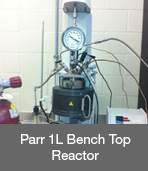Facilities & Equipment: Ozonolysis & Hydrogenation
.
Ozonolysis is the process of treating organic compounds with ozone to form ozonide. The ozonides can then undergo further processing to produce polyols (hydrogenation), acids, alcohols, aldehydes, and ketones.
The ozonolysis skid has been used to produce polyol from vegetable oil. The polyol has been used to make foam, bioplastic, and biocomposite. Foams synthesized from the polyol can be used by the automobile parts manufacturing industry for seats and by the construction material manufacturing industry for insulation and panel board. Polyols can also be found in common products for personal care.
Acids produced via ozonolysis also have foam application via esterification reactions.
Using ozonolysis and hydrogenation, a company can produce a mixture of light alcohols, mainly nonanol and 1-3 propane diol, which can be used in personal care products, plasticizers, resins, and adhesives. The benefit to the industries is that they are able to replace a petroleum-based product with a product made from vegetable oil.
Hydrogenation along with other reactions carried out under high pressure and temperature have produced biofuels from canola oil.
(Click on the image to enlarge the equipment photo.)
 | Parr 1L Bench Top Reactor
- Model: 4520
- Material: 316 stainless steel
- Rating: 1900 psi @ 350°C
- Other info: liquid sampling port; gas inlet; magnetic stirring
|
| | 
Alberta Agriculture & Forestry
Bio-Industrial Opportunities Section
O.S. Longman Building
4th Floor, 6909 - 116 Street
Edmonton Alberta T6H 4P2
Phone: (780) 644-8118
Email: biobranch@gov.ab.ca

Bio Processing Innovation Centre - Grand Opening and Open House
September 21, 2017
1:00 - 3:30pm
5520 - 36 Street, Edmonton, AB
Click here to register.
|